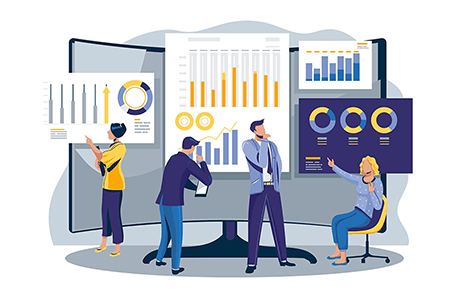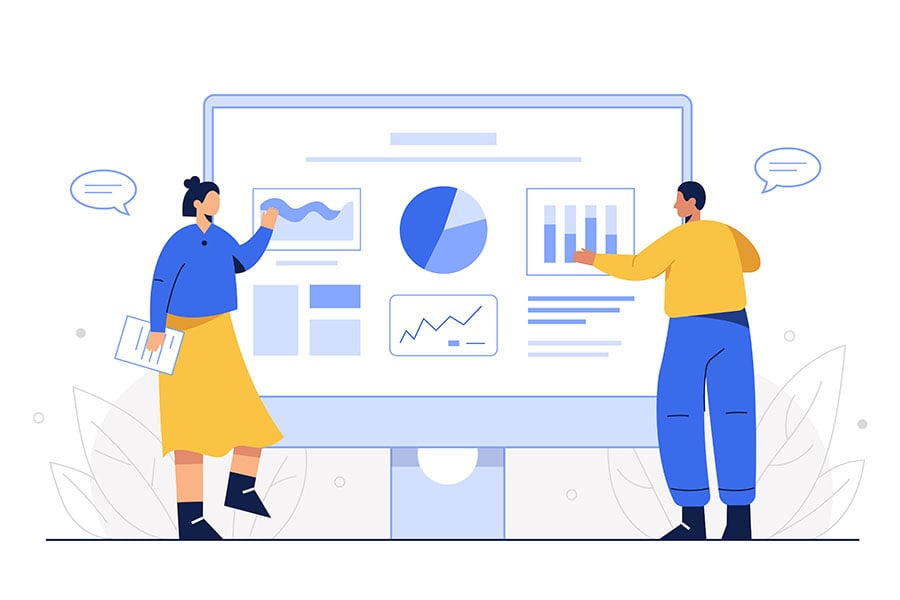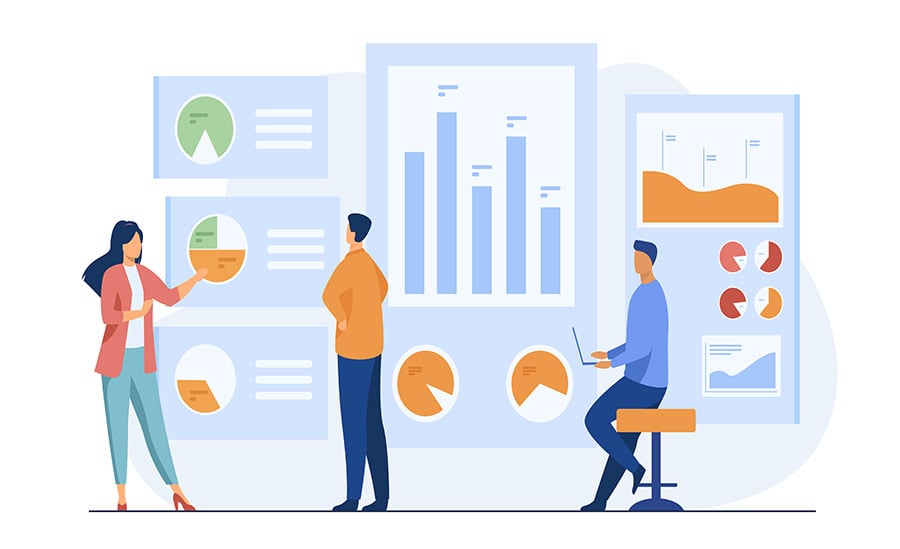When looking for data solutions for your organization, you'll undoubtedly hear the term "data mesh" thrown around. So, what is a data mesh?
A data mesh, by definition, is a data platform architecture that can allow end-users to access data quickly. This approach focuses on using data as a product. This is done without transporting data to a data lake or warehouse. It is an architectural system that makes your data accessible and secure.

This solves the challenges that come with traditional data platform architecture. Data meshes have four pillars on which it is built:
-
Decentralized domain ownership: This is the distribution of data responsibility across domains.
-
Data as a product: Each domain team is responsible for the coherence, availability, security, and quality of each data product.
-
Self-serve data infrastructure: This removes the bottlenecks of sharing data across teams by centralizing generalized operations.
-
Federated computational data governance: Data standardization makes it interoperable to avoid domains that cannot work together.
Features of Data Mesh: Data Mesh Explained
 What are a data mesh's main features? Data mesh has a heavy focus on decentralization. This enables the distribution of data ownership among different domain teams. This way, data can be managed independently and securely by each data team.
What are a data mesh's main features? Data mesh has a heavy focus on decentralization. This enables the distribution of data ownership among different domain teams. This way, data can be managed independently and securely by each data team.This process reduces obstructions and the use of restrictive data silos. The end goal is a scalable data solution that won't sacrifice data governance.
1. Create Self-Serve Data Use
Data mesh architecture allows independent teams to manage and work with the same data. However, this can only be done with technical experts' help. This allows teams to work faster and more efficiently on data projects. This also enables better collaboration and data management between different teams for collaboration.
Data meshes use a domain-driven design that delivers a self-serve data platform. This is what allows users to use data for their own specific data use cases. A central team ensures general standards for consistency for the data. However, each domain team can create local processes independent of each other.
This removes the challenge of having each domain team be autonomous. This central platform handles the storage and data pipeline engines so data teams can focus on their specialization.
For example, our customers leverage the Mactores Aedeon Data Lake framework eliminating barriers for data teams providing agility, data governance, and security, safeguarding sensitive data, and meeting industry compliance standards.
Data meshes use a domain-driven design that delivers a self-serve data platform. This is what allows users to use data for their own specific data use cases. A central team ensures general standards for consistency for the data. However, each domain team can create local processes independent of each other.
This removes the challenge of having each domain team be autonomous. This central platform handles the storage and data pipeline engines so data teams can focus on their specialization.
For example, our customers leverage the Mactores Aedeon Data Lake framework eliminating barriers for data teams providing agility, data governance, and security, safeguarding sensitive data, and meeting industry compliance standards.
2. Ensure High-Quality Data
When working with big data, instantaneous data access and response times are critical. Access to real-time information can enable your organization to make informed, data-driven decisions with accurate data.
Since a data mesh is a decentralized data architecture, data is delegated, with the responsibility lying at the domain level. With a central platform handling general standards for accessibility and consistency, each domain can access the same data and act independently. This means that each domain team's processes won't affect the data handled by another data team.
This reduces the likelihood of contaminated data and maintains data quality. It also reduces duplicated data as data volume increases. Data meshes can handle and run complex queries to deliver quick results. This enables your organization to make decisions faster.
For example, a customer offering a cross-industry SaaS product transformed their data platform by leveraging the Mactores Aedeon Data Lake and adopting a modern data mesh framework. This enabled them to act swiftly and incorporate multiple services in their data platform while taking care of their primary concern for real-time streaming with data governance.
Since a data mesh is a decentralized data architecture, data is delegated, with the responsibility lying at the domain level. With a central platform handling general standards for accessibility and consistency, each domain can access the same data and act independently. This means that each domain team's processes won't affect the data handled by another data team.
This reduces the likelihood of contaminated data and maintains data quality. It also reduces duplicated data as data volume increases. Data meshes can handle and run complex queries to deliver quick results. This enables your organization to make decisions faster.
For example, a customer offering a cross-industry SaaS product transformed their data platform by leveraging the Mactores Aedeon Data Lake and adopting a modern data mesh framework. This enabled them to act swiftly and incorporate multiple services in their data platform while taking care of their primary concern for real-time streaming with data governance.
3. Use Diverse Data Sources
Every organization has multiple data sources that need to be managed and analyzed. Data mesh architecture gives your organization a single source of truth. In traditional data architecture models, you may have divided data sources that don't work together to provide additional context. With a data mesh, you would have a single source to work with.
This makes it much easier for teams to deliver data products from an aggregated source of various datasets. An example of data mesh architecture could be a 360-degree view of customer data. Customer data includes demographics, geographic data, purchase history, shipments, and product ratings. Aggregating this data allows multiple teams to work with the same data to create multiple use cases for each domain.
In this example, a machine learning model can be used for use cases like:
This makes it much easier for teams to deliver data products from an aggregated source of various datasets. An example of data mesh architecture could be a 360-degree view of customer data. Customer data includes demographics, geographic data, purchase history, shipments, and product ratings. Aggregating this data allows multiple teams to work with the same data to create multiple use cases for each domain.
In this example, a machine learning model can be used for use cases like:
-
Determining product recommendations
-
Determining the bottlenecks in the customer journey
-
Detecting fraudulent behavior
4. Encourage Federated Data Governance
Domains in data mesh architecture are independent and interoperable. This makes it possible to govern data effectively as an organization. This creates fully autonomous data products. Here, each data product handles its own processes.
The governance execution model relies on automating the standards for each data product.
Each data product would then have its own infrastructure and data, making it secure and effective for use. This is especially important when establishing security policies and compliance standards for handling data. This ensures domains can operate independently, but standardization ensures datasets from different domains can interact.
Each data product would then have its own infrastructure and data, making it secure and effective for use. This is especially important when establishing security policies and compliance standards for handling data. This ensures domains can operate independently, but standardization ensures datasets from different domains can interact.
For example, when handling complex data, different teams might have a specific departmental topography to refer to the same thing. Each domain can operate with its own jargon, but fundamentally, each domain analyzes the same data. If working with marketing data in the United States, each domain might refer to the country as "U.S." or "USA." However, they access the marketing data from the same country regardless of the preferred language. A popular solution for customers is to deploy our Mactores Aedeon Data Lake automation, providing an out-of-the-box DataOPS automation to manage, monitor, remediate, and govern the data platform after deployment.
How Data Mesh Architecture Helps with Governance

Centralized data is dependent on importing and transporting data. With a decentralized data approach, each domain has separate data ownership. This reduces the time to access and enforce data processes.
Traditional data platform architecture becomes incredibly complex when there is an increase in data volume. Sometimes, this would require a change in data pipelines to accommodate an organization's needs. This needs to bode better for the agility necessary for modern businesses to scale their operations.
What is a data mesh's role in data governance? Data meshes improve data governance by:
- Decentralizing data, making it a scalable data architecture
- Promoting independence among domain teams
- Making critical data accessible
- Ensuring data transparency for use across domain teams
To highlight this point, one such use case is a custom implementation of the Mactores Aedeon Data Lake framework, allowing their teams to make business decisions 10x faster with exceedingly high governance and compliance requirements.
Get Started with a Modern Approach to Data Architecture

Data mesh architecture has endless possibilities for organizations. It can help you drive the business intelligence and insights you need with your data analytics.
Are you looking to automate your data platform? See how Mactores can help you today!


